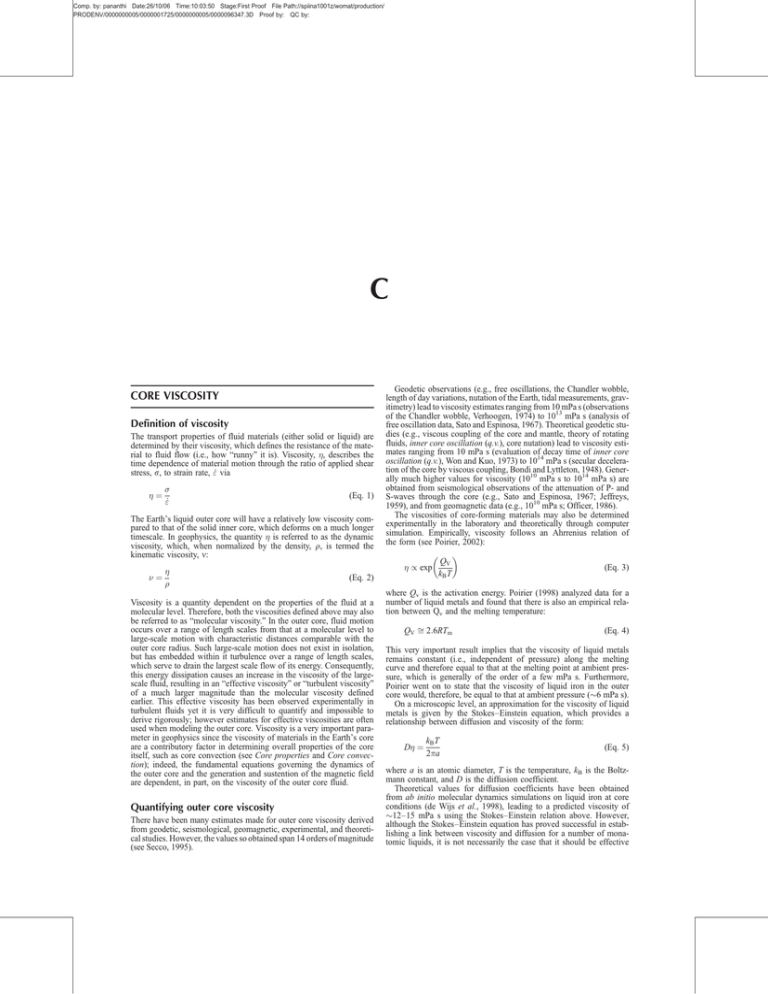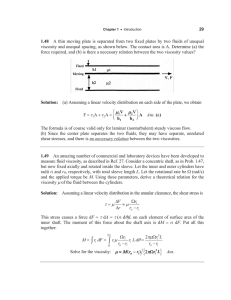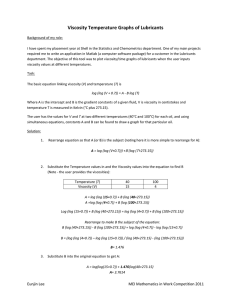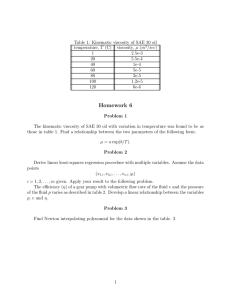Document 12881039
advertisement

Comp. by: pananthi Date:26/10/06 Time:10:03:50 Stage:First Proof File Path://spiina1001z/womat/production/ PRODENV/0000000005/0000001725/0000000005/0000096347.3D Proof by: QC by: C CORE VISCOSITY Definition of viscosity The transport properties of fluid materials (either solid or liquid) are determined by their viscosity, which defines the resistance of the material to fluid flow (i.e., how “runny” it is). Viscosity, , describes the time dependence of material motion through the ratio of applied shear stress, s, to strain rate, "_ via ¼ "_ (Eq. 1) The Earth's liquid outer core will have a relatively low viscosity compared to that of the solid inner core, which deforms on a much longer timescale. In geophysics, the quantity is referred to as the dynamic viscosity, which, when normalized by the density, r, is termed the kinematic viscosity, n: ¼ (Eq. 2) Viscosity is a quantity dependent on the properties of the fluid at a molecular level. Therefore, both the viscosities defined above may also be referred to as “molecular viscosity.” In the outer core, fluid motion occurs over a range of length scales from that at a molecular level to large-scale motion with characteristic distances comparable with the outer core radius. Such large-scale motion does not exist in isolation, but has embedded within it turbulence over a range of length scales, which serve to drain the largest scale flow of its energy. Consequently, this energy dissipation causes an increase in the viscosity of the largescale fluid, resulting in an “effective viscosity” or “turbulent viscosity” of a much larger magnitude than the molecular viscosity defined earlier. This effective viscosity has been observed experimentally in turbulent fluids yet it is very difficult to quantify and impossible to derive rigorously; however estimates for effective viscosities are often used when modeling the outer core. Viscosity is a very important parameter in geophysics since the viscosity of materials in the Earth's core are a contributory factor in determining overall properties of the core itself, such as core convection (see Core properties and Core convection); indeed, the fundamental equations governing the dynamics of the outer core and the generation and sustention of the magnetic field are dependent, in part, on the viscosity of the outer core fluid. Quantifying outer core viscosity There have been many estimates made for outer core viscosity derived from geodetic, seismological, geomagnetic, experimental, and theoretical studies. However, the values so obtained span 14 orders of magnitude (see Secco, 1995). Geodetic observations (e.g., free oscillations, the Chandler wobble, length of day variations, nutation of the Earth, tidal measurements, gravitimetry) lead to viscosity estimates ranging from 10 mPa s (observations of the Chandler wobble, Verhoogen, 1974) to 1013 mPa s (analysis of free oscillation data, Sato and Espinosa, 1967). Theoretical geodetic studies (e.g., viscous coupling of the core and mantle, theory of rotating fluids, inner core oscillation (q.v.), core nutation) lead to viscosity estimates ranging from 10 mPa s (evaluation of decay time of inner core oscillation (q.v.), Won and Kuo, 1973) to 1014 mPa s (secular deceleration of the core by viscous coupling, Bondi and Lyttleton, 1948). Generally much higher values for viscosity (1010 mPa s to 1014 mPa s) are obtained from seismological observations of the attenuation of P- and S-waves through the core (e.g., Sato and Espinosa, 1967; Jeffreys, 1959), and from geomagnetic data (e.g., 1010 mPa s; Officer, 1986). The viscosities of core-forming materials may also be determined experimentally in the laboratory and theoretically through computer simulation. Empirically, viscosity follows an Ahrrenius relation of the form (see Poirier, 2002): QV / exp (Eq. 3) kB T where Qv is the activation energy. Poirier (1998) analyzed data for a number of liquid metals and found that there is also an empirical relation between Qv and the melting temperature: QV ffi 2:6RTm (Eq. 4) This very important result implies that the viscosity of liquid metals remains constant (i.e., independent of pressure) along the melting curve and therefore equal to that at the melting point at ambient pressure, which is generally of the order of a few mPa s. Furthermore, Poirier went on to state that the viscosity of liquid iron in the outer core would, therefore, be equal to that at ambient pressure (6 mPa s). On a microscopic level, an approximation for the viscosity of liquid metals is given by the Stokes–Einstein equation, which provides a relationship between diffusion and viscosity of the form: D ¼ kB T 2a (Eq. 5) where a is an atomic diameter, T is the temperature, kB is the Boltzmann constant, and D is the diffusion coefficient. Theoretical values for diffusion coefficients have been obtained from ab initio molecular dynamics simulations on liquid iron at core conditions (de Wijs et al., 1998), leading to a predicted viscosity of 12–15 mPa s using the Stokes–Einstein relation above. However, although the Stokes–Einstein equation has proved successful in establishing a link between viscosity and diffusion for a number of monatomic liquids, it is not necessarily the case that it should be effective Comp. by: pananthi Date:26/10/06 Time:10:03:52 Stage:First Proof File Path://spiina1001z/womat/production/ PRODENV/0000000005/0000001725/0000000005/0000096347.3D Proof by: QC by: 2 CORE VISCOSITY for alloys or at high pressures and temperatures. To address the validity of the Stokes–Einstein relation and to assess the effect of impurities on viscosity coefficients, a number of experimental and theoretical studies have been performed on the Fe–FeS system. High-pressure tracer diffusion experiments (Dobson et al., 2001) have been carried out on liquid Fe–FeS alloys at 5 GPa, resulting in high diffusivities (10–5 cm2 s1) in excellent agreement with ab initio molecular dynamics calculations performed at the same conditions (Vočadlo et al., 2000). When incorporated into equations 5, these diffusivities lead to values for viscosity of a few mPa s. Direct viscosity measurements (Dobson et al., 2000) of Fe–FeS alloys by means of the falling-sphere technique have been made at similar pressures and temperatures to those used in the diffusion experiments above; these resulted in values for viscosities in excellent agreement with those derived experimentally using the Stokes– Einstein relation. Furthermore these results are in excellent agreement with ab initio molecular dynamics calculations of viscosity based on rigorous Green–Kubo functions of the stresses obtained directly from the simulations (Vočadlo et al., 2000). All of these results thus provide both experimental and theoretical verification of the Stokes–Einstein relation (equation 5). The results from these studies further show not only that the viscosity of liquid iron at core pressures is approximately equal to that at low pressures, verifying Poirier's groundbreaking and insightful result (Poirier, 1988), but also that the introduction of light elements into Fe liquid does not appear significantly to effect the values. Both ab initio calculations and experiments consistently give viscosities of the order of a few mPa s. This suggests that viscosity changes little with homologous temperature, and it is now generally accepted that the viscosity of the outer core is likely to be a few mPa s (comparable to that of water on the Earth's surface). In general, viscosities derived from Earth observations are high (107–1014 mPa s) and those based on laboratory experiments and theoretical considerations are much lower (1–10 mPa s). The disparate values for viscosity arise for two main reasons: the type of viscosity being measured (molecular or effective) and the large uncertainties associated with the interpretation of Earth observation data. It is also possible that viscosity measurements made from the direct observations of the Earth are not actually measuring viscosity at all, but some other effects that are being attributed to viscosity; this would certainly be the case if the “true” viscosity were of the order of mPa s, since such a small viscosity is unlikely to be detectable. A low viscosity leads to viscous forces that are essentially negligible when compared to the Coriolis force, supporting the view of an outer core in a state of small-circulation turbulent convection rather than a more coherent pattern of convection on a much larger scale comparable with the core radius. If this is the case, it is necessary to obtain accurate values for viscosity in order to quantify this turbulence in the outer core. Viscosity and the inner core The inner core is not perfectly elastic and has a finite viscosity with deformation occurring over long timescales. Placing numerical constraints on the viscosity of the inner core is fundamental to understanding important core processes such as differential inner core rotation (q.v.), inner core oscillation (q.v.), and inner core anisotropy (q.v.) (see Bloxham, 1988). High-temperature experiments on solid iron at ambient pressure lead to estimates for viscosities of 1013 Pa s (Frost and Ashby, 1982); however, this is likely to be a lower limit as the value may increase at higher pressures. Seismological and geodetic observations have led to a number of estimates for inner core viscosity ranging from 1011 to 1020 Pa s (see Dumberry and Bloxham, 2002). In particular, Buffett (1997) modeled the viscous relaxation of the inner core by calculating the relaxation time for the inner core to adjust, as it rotates, back to its equilibrium shape after small distortions due to perturbations in gravitational potential imposed by the overlying mantle. He suggested that the viscosity has to be constrained to be either less than 1016 Pa s (if the whole inner core is involved in the relaxation) or greater than 1020 Pa s (if there is no relaxation of the inner core), although this latter case may lead to gravitational locking and hence no differential rotation. Quantifying the viscosity of the phases present in the inner core at a microscopic level is a very difficult problem. At temperatures close to the melting point (as expected in the inner core) viscous flow is likely to be determined either by dislocation creep (Harper–Dorn creep) or diffusion creep (Nabarro–Herring creep). The overall viscosity of inner core material has diffusion-driven and dislocation-driven contributions: ¼ 1 diff þ 1 disl 1 (Eq. 6) Diffusion-controlled viscosity, whereby the material strain is caused by the motion of lattice defects (e.g., vacancies) under applied stress, is given by diff ¼ d 2 RT Dsd V (Eq. 7) where d is the grain size, R is the gas constant, T is the temperature, a is a geometric constant, and V is the volume. The self-diffusion coefficient, Dsd, is given by H (Eq. 8) Dsd ¼ D0 exp RT where D0 is a preexponential factor and DH is the activation enthalpy for self-diffusion. For simple materials, dislocation-controlled viscosity, whereby material strain is caused by the movement of linear defects along crystallographic planes, is given by disl ¼ RT Dsd V (Eq. 9) where r is the dislocation density. Both dislocation- and diffusion-controlled creep mechanisms are thermally activated and the thermally controlled parameter in both cases is the self-diffusion coefficient, Dsd. A commonly used empirical relation for metals assumes that DH is linearly proportional to the melting temperature, Tm, and hence that gTm (Eq. 10) Dsd ¼ D0 exp T where g is a constant taking a value of 18 for metals (Poirier, 2002). Considering iron close to its melting point at core pressures (5500 K), and using reasonable estimates for other quantities in equations 7, 9, and 10 (a 42, D010–5 m2 s1, V5 10–6 m3 mol1), we obtain values for diff and disl of 1021 d2 Pa s and 6 1022/r Pa s, respectively. Unfortunately, the strong dependence of the viscosity expressions on the completely unknown quantities of grain size and dislocation density means that it is extremely difficult to produce reliable final numerical values. Grain sizes in the inner core could be anything from 10–3–103 m, resulting in diffusion viscosities in the range 1015–1027 Pa s; dislocation densities could be as low as 106 m2 or nearer to the dislocation melting limit of 1013 m2, resulting in dislocation driven viscosities of 109–1016 Pa s. Thus, even the relative contributions from dislocation controlled and diffusion controlled viscosity are as yet unknown. Clearly, inner core viscosity is not a well-constrained property, with estimates varying over many orders of magnitude. Future microscopic simulations, combined with high-resolution seismic and geodetic data, should constrain this quantity further and thereby improve our understanding of inner core dynamics. Lidunka Vočadlo Bibliography Bloxham, J., 1988. Dynamics of angular momentum in the Earth's core. Annual Reviews in Earth and Planetary Science, 26: 501– 517. Bondi, H., and Lyttleton, R.A., 1948. On the dynamical theory of the rotation of the Earth. Proceedings of the Cambridge Philosophical Society, 44: 345–359. Buffet, B.A., 1997. Geodynamic estimates of the viscosity of the Earth's inner core. Nature, 388: 571–573. Comp. by: pananthi Date:26/10/06 Time:10:03:55 Stage:First Proof File Path://spiina1001z/womat/production/ PRODENV/0000000005/0000001725/0000000005/0000096347.3D Proof by: QC by: CORE VISCOSITY Dobson, D.P., Crichton, W.A., Vočadlo, L., Jones, A.P., Wang, Y., Uchida, T., Rivers, M., Sutton, S., and Brodholt, J., 2000. In situ measurement of viscosity of liquids in the Fe–FeS system at high pressures and temperatures. American Mineralogist, 85: 1838–1842. Dobson, D.P., Brodholt, J.P., Vočadlo, L., and Chrichton, W., 2001. Experimental verification of the Stokes–Einstein relation in liquid Fe–FeS at 5 GPa. Molecular Physics, 99: 773–777. Dumberry, M., and Bloxham, J., 2002. Inner core tilt and polar motion. Geophysical Journal International, 151: 377–392. Frost, H.J., and Ashby, M.F., 1982. Deformation Mechanism Maps. Oxford: Pergamon Press. Jeffreys, H., 1959. The Earth, its Origin, History and Physical Constitution. Cambridge: Cambridge University Press. Poirier, J.P., 1988. Transport properties of liquid metals and viscosity of the Earth's core, Geophysical Journal International, 92: 99–105. Poirier, J.P., 2002. Rheology: elasticity and viscosity at high pressure. In Hemley, R.J., Chiarotti, G.L., Bernasconi, M., and Ulivi, L. (eds.), Proceedings of the International School of Physics “Enrico Fermi”, Amsterdam: IOS Press. Course CXLVII. Officer, C.B., 1986. A conceptual model of core dynamics and the Earth's magnetic field. Journal of Geophysics, 59: 89–97. Sato, R., and Espinosa, A.F., 1967. Dissipation factor of the torsional mode T2 for a homogeneous mantle Earth with a soft-solid or viscous-liquid core. Journal of Geophysical Research, 72: 1761– 1767. 3 Secco, R.A., 1995. Viscosity of the outer core. In Ahrens, T.J. (ed.), Mineral Physics and Crystallography: A Handbook of Physical Constants, AGU Reference Shelf 2. Washington, D.C.: American Geophysical Union. Verhoogen, J., 1974. Chandler wobble and viscosity in the Earth's core. Nature, 249: 334–335. Vočadlo, L., Alfè, D., Price, G.D., and Gillan, M.J., 2000. First principles calculations on the diffusivity and viscosity of liquid Fe–S at experimentally accessible conditions. Physics of the Earth and Planetary Interiors, 120: 145–152. de Wijs, G.A., Kresse, G., Vočadlo, L., Dobson, D.P., Alfè, D., Gillan, M.J., and Price, G.D., 1998. The viscosity of liquid iron at the physical conditions of the Earth's core. Nature, 392: 805–807. Won, I.J., and Kuo, J.T., 1973. Oscillation of the Earth's inner core and its relation to the generation of geomagnetic field, Journal of Geophysical Research, 78: 905–911. Cross-references Core Convection Core Properties, Physical Core Properties, Theoretical Determination Inner Core Anisotropy Inner Core Oscillation Inner Core Rotation





